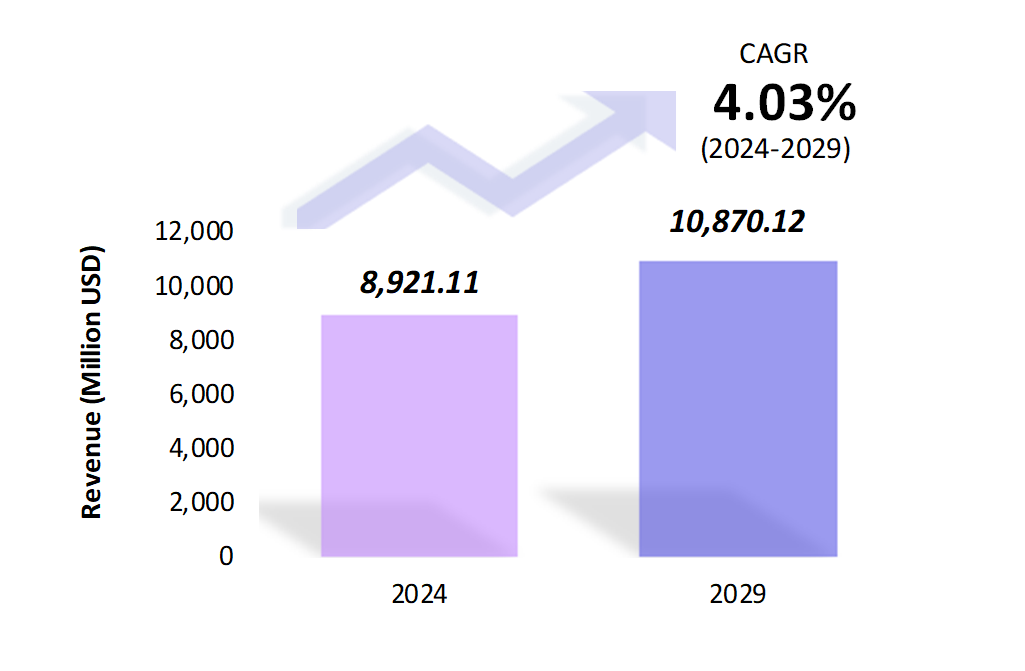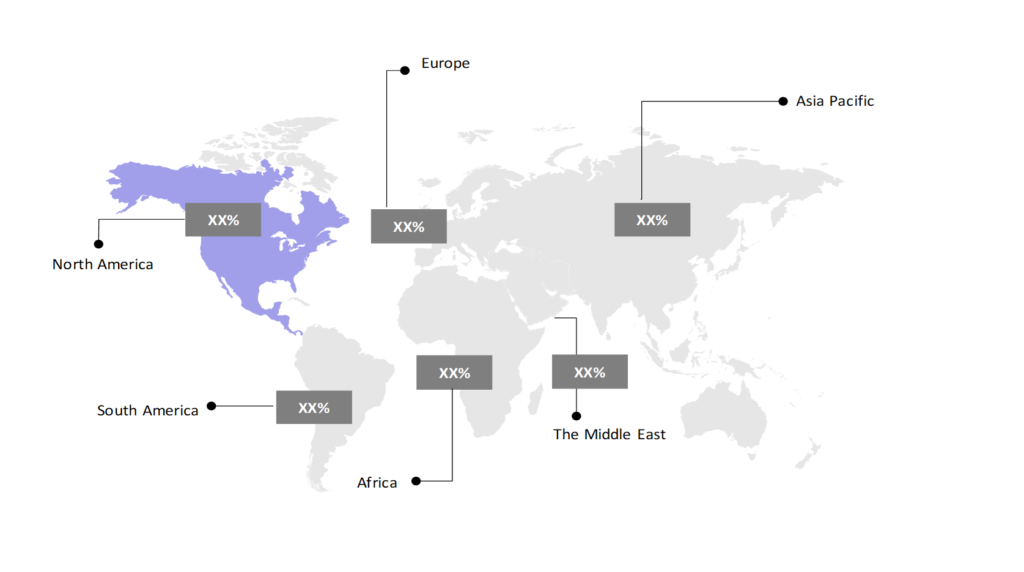Military Rotorcraft Market Analysis: Growth, Size, Share & Future Trends (2024-2029)
The market report offers a detailed analysis segmented by Type (Attack Helicopters, Transport Helicopters, Multi-mission Helicopters, Training Helicopters); by Geography (North America, South America, Asia Pacific, Europe, The Middle East, Africa).
Outlook

- The military rotorcraft market is estimated to be at USD 8,921.11 Mn in 2024 and is anticipated to reach USD 10,870.12 Mn in 2029.
- The military rotorcraft market is registering a CAGR of 4.03% during the forecast period 2024-2029.
- Rising defense budgets fuel the global military rotorcraft market, advancements in rotorcraft technologies, and the demand for updated aerial capabilities. Increasing geopolitical tensions and the modernization programs of armed forces are significant factors bolstering market growth.
Request a free sample.
Ecosystem

- The participants in the global military rotorcraft industry are always developing their strategies to preserve a competitive advantage.
- These companies focus on developing multi-mission, unmanned, and hybrid-electric rotorcraft that will continue to shape the future of military aviation.
- Several important entities in the military rotorcraft market include Airbus SE; The Boeing Co.; Leonardo SpA; Textron Inc.; Lockheed Martin Corp.; and others.
Ask for customization.
Findings
| Attributes | Values |
|---|---|
| Historical Period | 2018-2022 |
| Base Year | 2023 |
| Forecast Period | 2024-2029 |
| Market Size (2024) | USD 8,921.11 Mn |
| Market Size (2029) | USD 8,921.11 Mn |
| Growth Rate | 4.03% CAGR from 2024 to 2029 |
| Key Segments | Type (Attack Helicopters, Transport Helicopters, Multi-mission Helicopters, Training Helicopters); Geography (North America, South America, Asia Pacific, Europe, The Middle East, Africa) |
| Key Vendors | Airbus SE; The Boeing Co.; Leonardo SpA; Textron Inc.; Lockheed Martin Corp. |
| Key Countries | The US; Canada; Mexico; Brazil; Argentina; Colombia; Chile; China; India; Japan; South Korea; The UK; Germany; Italy; France; Spain; Turkey; UAE; Saudi Arabia; Egypt; South Africa |
| Largest Market | North America |
Get a free quote.
Trends
- Shift Toward Multi-Mission Rotorcraft: Armed forces increasingly seek rotorcraft that can perform multiple missions, such as combat, rescue, and transport, reducing the need for specialized fleets. In 2023, Lockheed Martin introduced its Sikorsky CH-53K King Stallion, a heavy-lift helicopter with enhanced versatility capable of executing diverse military missions in harsh environments.
- Focus on Stealth and Low-Visibility Technologies: Military rotorcraft is increasingly designed to reduce radar visibility with stealth capabilities. In 2023, Boeing developed the Raider X helicopter for the US Army’s Future Attack Reconnaissance Aircraft (FARA) program, utilizing low-visibility technology to enhance survivability in contested environments.
- Adoption of Hybrid-Electric Propulsion Systems: In line with global sustainability goals, there is growing interest in hybrid-electric propulsion systems for military rotorcraft. Airbus is spearheading the development of a hybrid-electric helicopter, with plans to launch a prototype by 2026. The helicopter aims to reduce fuel consumption and emissions while maintaining performance.
Speak to analyst.
Catalysts
- Growing Military Modernization Programs: The modernization of military forces, with a strong emphasis on enhancing rotorcraft capabilities, drives growth in the aerospace and defense markets. Increased investments in advanced rotorcraft technologies and upgrades to existing systems fuel demand for state-of-the-art solutions, boosting market opportunities and innovations.
- Rising Demand for Search and Rescue Operations: Military rotorcraft is crucial in humanitarian missions such as disaster relief and search and rescue (SAR) operations. In 2022, NATO deployed several military helicopters for SAR operations in flood-affected areas in Europe, showcasing the increasing need for rotorcraft in non-combat roles.
- Focus on Upgrading Aging Fleets: Many countries focus on replacing or upgrading their aging rotorcraft fleets to meet modern battlefield requirements. In 2023, Germany initiated a multi-billion-dollar program to replace its aging fleet of Bell UH-1D helicopters with modern, technologically advanced models, ensuring enhanced operational readiness.
Inquire before buying.
Restraints
- High Cost of Development and Procurement: The development and procurement of advanced military rotorcraft entails substantial costs, which can be a significant barrier for budget-constrained nations. High expenses related to research, development, and acquisition of cutting-edge technologies limit these nations’ ability to adopt and integrate new rotorcraft into their fleets.
- Stringent Regulatory and Certification Processes: Developing rotorcraft with advanced technologies like stealth and autonomous systems requires meeting stringent safety and regulatory standards. In 2022, delays in certification processes for Sikorsky’s SB-1 Defiant, a high-speed helicopter, exemplified the complexities of bringing new rotorcraft technologies to the market.
- Operational Maintenance and Lifecycle Costs: Military rotorcraft demand extensive maintenance and frequent servicing, significantly increasing operational costs throughout their lifecycle. This includes regular inspections, repairs, and parts replacements, all contributing to higher long-term expenses.
Personalize this research.
Hotspot

Explore purchase options.
Table of Contents
| 1. Introduction 1.1. Research Methodology 1.2. Scope of the Study 2. Market Overview / Executive Summary 2.1. Global Military Rotorcraft Market (2018 – 2022) 2.2. Global Military Rotorcraft Market (2023 – 2029) 3. Market Segmentation 3.1. Global Military Rotorcraft Market by Type 3.1.1. Attack Helicopters 3.1.2. Transport Helicopters 3.1.3. Multi-mission Helicopters 3.1.4. Training Helicopters 4. Regional Segmentation 4.1. North America 4.1.1. The US 4.1.2. Canada 4.1.3. Mexico 4.2. South America 4.2.1. Brazil 4.2.2. Argentina 4.2.3. Colombia 4.2.4. Chile 4.2.5. Rest of South America 4.3. Asia Pacific 4.3.1. China 4.3.2. India 4.3.3. Japan 4.3.4. South Korea 4.3.5. Rest of Asia Pacific 4.4. Europe 4.4.1. The UK 4.4.2. Germany 4.4.3. Italy 4.4.4. France 4.4.5. Spain 4.4.6. Rest of Europe 4.5. The Middle East 4.5.1. Turkey 4.5.2. UAE 4.5.3. Saudi Arabia 4.5.4. Rest of the Middle East 4.6. Africa 4.6.1. Egypt 4.6.2. South Africa 4.6.3. Rest of Africa 5. Value Chain Analysis of the Global Military Rotorcraft Market 6. Porter Five Forces Analysis 6.1. Threats of New Entrants 6.2. Threats of Substitutes 6.3. Bargaining Power of Buyers 6.4. Bargaining Power of Suppliers 6.5. Competition in the Industry 7. Trends, Drivers and Challenges Analysis 7.1. Market Trends 7.1.1. Market Trend 1 7.1.2. Market Trend 2 7.1.3. Market Trend 3 7.2. Market Drivers 7.2.1. Market Driver 1 7.2.2. Market Driver 2 7.2.3. Market Driver 3 7.3. Market Challenges 7.3.1. Market Challenge 1 7.3.2. Market Challenge 2 7.3.3. Market Challenge 3 8. Opportunities Analysis 8.1. Market Opportunity 1 8.2. Market Opportunity 2 8.3. Market Opportunity 3 9. Competitive Landscape 9.1. Airbus SE 9.2. The Boeing Co. 9.3. Leonardo SpA 9.4. Textron Inc. 9.5. Lockheed Martin Corp. 9.6. Company 6 9.7. Company 7 9.8. Company 8 9.9. Company 9 9.10. Company 10 |
Know the research methodology.
Military Rotorcraft Market – FAQs
1. What is the current size of the military rotorcraft market?
Ans. In 2024, the military rotorcraft market size is USD 8,921.11 Mn.
2. Who are the major vendors in the military rotorcraft market?
Ans. The major vendors in the military rotorcraft market are Airbus SE; The Boeing Co.; Leonardo SpA; Textron Inc.; Lockheed Martin Corp.
3. Which segments are covered under the military rotorcraft market segments analysis?
Ans. The military rotorcraft market report offers in-depth insights into Type, and Geography.
